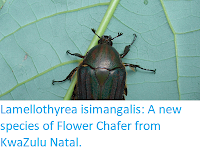Scarab Beetles, Scarabeidae, are a large and diverse group, containing about 30 000 known species from around the world. These Beetles are typically large and robust, and often with a metallic colouration. Many Scarab Beetles are excellent diggers, and many of these digging Scarabs share a habit of burying their eggs with a supply of dung to feed their young, gaining them the name Dung Beetles, though others lay their eggs on carrion, decaying plant matter, or in some cases living plants. Flower Chafers, Cetoniinae, are Scarab Beetles that feed as adults on the nectar and pollen of flowers. The larval habits of this group are variable, with some species predating the larvae of other Insects and others feeding on Bird Droppings - the later being particularly true of Southern African species.
The genus Callophylla is currently known from only three species, and a very limited number of specimens. Callophylla costata was first described based upon a single male specimen from central Cameroon in 2016. A female collected from Mount Nimba in Guinea was assigned to the same species in 1954, then redescribed as a new species, Callophylla lamottei, in 2007, when the actual female of Callophylla costata was discovered. In 2015 a third species, Callophylla takanoi, was described based upon a male found in western Zambia during a survey undertaken to the region by the British Natural History Museum.
In a paper published in the journal ZooKeys on 23 January 2019, Renzo Perissinotto of the School of Environmental Sciences at Nelson Mandela University describes a new species of Callophylla, from a single male found in the collection of the Ditsong National Museum of Natural History in Pretoria, which was apparently collected by the German entomologist Paul Norbert Schürhoff in what is now southern Tanzania in the early twentieth century.
The new species is given the name Callophylla macrocephala, meaning ‘big head’ as its head, and in particular its clypeus (forepart of the head, resembling the face of a vertebrate), is notably larger and wider than other known members of the genus. The specimen is 12.8 mm long and 5.3 mm wide, and black in colour with ochre markings on its elytra (wing cases), and scattered, horseshoe-shaped perforations on its protonum (thorax).
The new species is given the name Callophylla macrocephala, meaning ‘big head’ as its head, and in particular its clypeus (forepart of the head, resembling the face of a vertebrate), is notably larger and wider than other known members of the genus. The specimen is 12.8 mm long and 5.3 mm wide, and black in colour with ochre markings on its elytra (wing cases), and scattered, horseshoe-shaped perforations on its protonum (thorax).
Dorsal (A) and ventral (B) habitus of Callophylla macrocephala. Perissinotto (2019).
Like other members of the genus Callophylla, Callophylla macrocephala lacks any form of mouthparts, and apparently cannot feed as an adult. Perissinotto suggests that this inability of adults of the genus to feed, combined with a distribution in highland regions, may explain the apparent rarity of the genus. Species confined to high altitudes are effectively living in islands cut off from other members of the same species by areas of uninhabitable lowland. This means that individual species tend to have very local distributions, and any population which somehow gets transplanted to a new ‘island’ is effectively cut off from the population from which it came, enabling new species to form easily. Where an insect has only a very short adult lifespan, then adults will only be seen for a few days at one time of year, making it unlikely that collection entomlogists will happen to wander through at the right moment.
See also...
The specimen is labelled as having come from the ‘Nakonde Hochland’ (Nakonde Highlands) area of Deutsch-Ostafrika, presumed to be the Lindi District of German Tanganyika (modern Zambia), which lies across the border from the town of Nakonde, in what was then the British colony of Northern Rhodesia and is now Zambia. The specimen does not appear to have been mentioned in any of Schürhoff’s numerous publications on Flower Chafers.
Type localities of Callophylla macrocephala (blue circle) and Callophylla takanoi (red circle) in Central – East Africa. Perissinotto (2019).
Like other members of the genus Callophylla, Callophylla macrocephala lacks any form of mouthparts, and apparently cannot feed as an adult. Perissinotto suggests that this inability of adults of the genus to feed, combined with a distribution in highland regions, may explain the apparent rarity of the genus. Species confined to high altitudes are effectively living in islands cut off from other members of the same species by areas of uninhabitable lowland. This means that individual species tend to have very local distributions, and any population which somehow gets transplanted to a new ‘island’ is effectively cut off from the population from which it came, enabling new species to form easily. Where an insect has only a very short adult lifespan, then adults will only be seen for a few days at one time of year, making it unlikely that collection entomlogists will happen to wander through at the right moment.
See also...
Follow Sciency Thoughts on Facebook.








